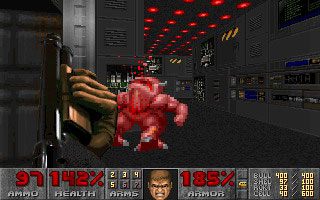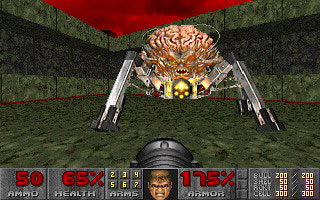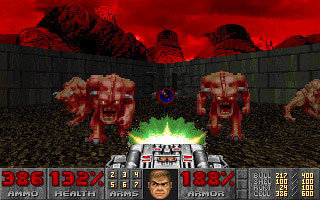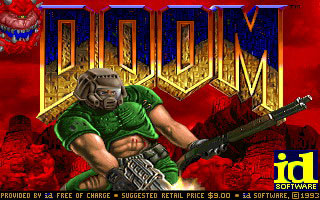The Greatest Games of All Time: Doom
It wouldn't be fair to say Doom was the first first-person shooter, but it can be said that it's inarguably the most important. Without this seminal game from id Software, the shooter genre--heck, all of gaming--simply wouldn't be what it is today.
It wouldn't be fair to say Doom was the first first-person shooter, but it can be said that it's inarguably the most important. Without this seminal game from id Software, the shooter genre--heck, all of gaming--simply wouldn't be what it is today. To give you an idea of Doom's significance, the game was solely responsible for the word "deathmatch" and its entry into the greater gaming lexicon. Yeah, it was that influential.
To be fair, it was another id game, Wolfenstein 3D, that in 1992 introduced gamers to the concept of the first-person shooter. The game's go-anywhere, shoot-anything freedom set the PC gaming world abuzz, and Wolfenstein became a popular demo application that could be found running in mom-and-pop computer stores across the country. Wolfenstein wasn't just an enhanced version of an existing concept--it was an entirely new kind of game. Fans were floored that they could explore the dank corridors of World War II Germany from the perspective of Ally hero BJ Blazkowicz--gunning down Nazi foes with a frenzied aplomb. Plus, you know, it had Hitler in a robot suit. Needless to say, Wolfenstein went over well with hardcore gamers.

But it wasn't until the arrival of Doom in December of 1993 that id showed action fans the full potential of the first-person shooter's ability to enthrall and terrify. The game's premise was simple enough. You played as a space marine stationed on the Martian moon of Phobos, where the Union Aerospace Corporation has been conducting experiments with matter teleportation. Those lousy scientists manage to open a rift to hell, from which spews forth a terrible demonic host that slaughters everyone at the base--except you. So it was up to you to grab the nearest weapon and blast your way through the hordes, eventually neutralizing the very source of the threat within hell's own gaping maw.
Sounds not unlike any number of thin, sci-fi-style video game plots, huh? What made Doom so incredible was the intense, gut-level impact of its nonstop shooting action, enabled in large part by the game's then radically new technology. From a mechanical perspective, Doom was leaps and bounds ahead of Wolfenstein. The older game's levels were uniformly built--from right-angle corners to fixed-height ceilings, Wolfenstein looked like the same room over and over again.

By contrast, Doom's new engine enabled far more creative level design. It let id's designers put walls together at all sorts of crazy angles and set variable ceiling heights, which combined to make for very interesting architecture. The game introduced stairs, elevators, and raised platforms to the genre--all revolutionary at the time. By far the most important new feature, though, was the lighting, which could be varied in intensity to create flickering overhead lights and patches of near-total darkness. With creative level design and innovative lighting and mechanics, Doom's levels were far more ambient and downright scary than the endless rooms and hallways of Wolfenstein.
Luckily, id's artists and designers knew what to do with these tools. Just as important as Doom's shiny new engine was their flaming-skulls-and-pentagrams enthusiasm for the source material. The ideas for Doom's hellish host seemed to spring from the margins of some Metallica-loving, denim jacket-wearing middle school student's spiral notebook--and that just made the game all the more endearing. Every rounded corner revealed a snarling demon or mutilated scientist, and the adversaries got more grotesque and scary (not to mention harder to kill) as you blasted your way through the game's many levels. Who could forget the bull-like pinky demon; the ubiquitous, fireball-flinging imps; and the hideous spider mastermind at the end of the game? Blasting these enemies with the game's diverse array of weaponry was gleefully perverse. Doom's presentation was a little tongue in cheek, and completely over the top.

And then there was the deathmatch. As engrossing and unnerving as Doom's single-player game was, it was the multiplayer mode that made the biggest and most enduring impression. For all practical purposes, id invented the idea of a bunch of people slaughtering each other simultaneously within one networked computer game. By modern standards, the game's four-player, LAN-only limitations are positively archaic. But at the time, there was nothing like a four-player Doom deathmatch, and it became a phenomenon on collegiate and corporate networks. Stories from back in the day tell of legions of companies who were forced to ban Doom during work hours in the face of clogged networks and lost productivity. The influence of Doom, the online, multiplayer killer app, is now felt in applications ranging from Counter-Strike to Xbox Live.
In fact, the Doom legacy has persisted in ways even the original id team couldn't have imagined. The game became a major motion picture last year, while a book chronicling Doom's development delivered for diehard fans yearning for a behind-the-scenes scoop. Of course, no one is more responsible for the resurgence of interest in Doom than id itself, which finally released its own technologically advanced reimagining of the game in 2004. Though it was generally well received, many found it to lack the creative spark--that gory heart and soul of the original Doom. But despite its numerous appearances in other formats and on other media, longtime fans will forever remember the original 1993 release of Doom as the beginning of a true revolution in action gaming. --Brad Shoemaker
Got a news tip or want to contact us directly? Email news@gamespot.com

Join the conversation